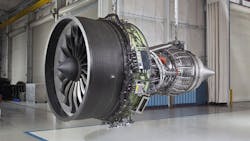Pressure continues to build for GE Aviation and Boeing Commercial Airplanes to address defects in the former’s GEnx engines that power Boeing’s 787 Dreamliners and 747-8 cargo jets. General Electric Co intends to issue a new service bulletin for airlines to inspect the GEnx engines, to determine the extent of damage in a part of the engine that failed on a 747-8 freighter recently in China.
The Shanghai incident had been raised last month in relation to two other GEnx failures on 787 Dreamliners. GE determined that the problems on the 787s involved cracks on the engines’ fan mid-shafts.
Now, according to reports, investigators are concerned with the engines’ low-pressure turbine. "We're issuing a service bulletin within the next day or two to all the GEnx operators, and what that will do is call for an inspection of the low-pressure turbine area," according to Rick Kennedy, a GE spokesman.
In a related development, Qatar Airways — which has ordered a total of 60 Dreamliners —stated it would not take delivery of the jets until the issues are resolved. "The 787 has an engine with new technology. However, there has been a material defect in the engine which now needs replacement and inspection," according to Qatar Airways CEO Akbar Al-Baker. "We have informed Boeing that we will not take delivery until the 787s have the new modified shaft."
GE Aviation’s GEnx dual-rotor turbofan engine is its most recent jet engine development, and it is installed in the Boeing 787 and 747-8. It is one engine option for Boeing’s Dreamliner; another choice is the Rolls-Royce Plc Trent 1000. About 120 GEnx engines have delivered to date, and an estimated 1,000 have been ordered, according to GE.
The concern for the Dreamliners stems from the discovery of debris during a July preflight test in Charleston, S.C. Reportedly, another similar crack was found late in August on an engine installed in a different 787, also not yet in service.
Last month the National Transportation Safety Board urged the Federal Aviation Administration to require more frequent inspections of the GEnx-1B and GEnx-2B. FAA determined that jets with the GEnx engine should have their fan shafts inspected every 90 days.
GE’s investigation concluded that fan mid-shafts on the GEnx engines had fractured or cracked at the forward end of the shaft, where a retaining nut is installed. It identified the problem as an effect of an environmentally friendly coating for the mid-shaft, one containing less lead than had been contained in the previous formulation. The manufacturer determined that the new coating traps moisture on the shafts and weakens them. It intends to resume using use the previous coating to provide a stronger protective coating on engines still being manufactured.
"GE is working very closely with its customers as the GEnx fleet is being very successfully managed in the field with regards to the fan mid-shaft issue," according to Kennedy, quoted by Reuters. "The entire fleet in operation has been inspected with no issues."
In the incident in Shanghai, a 747 cargo jet lost thrust and was forced to cancel its takeoff last month. The engine had not been inspected for the mid-shaft problem, though the current development points to the low-pressure turbine as the caused of the engine failure.
No one has been injured in any of the incidents.
About the Author
Robert Brooks
Content Director
Robert Brooks has been a business-to-business reporter, writer, editor, and columnist for more than 20 years, specializing in the primary metal and basic manufacturing industries.
